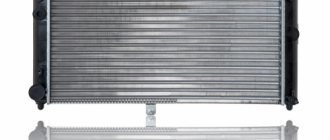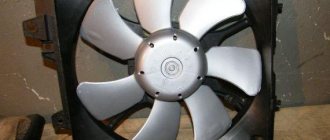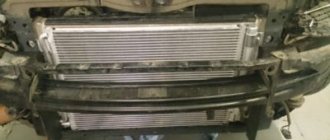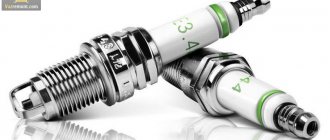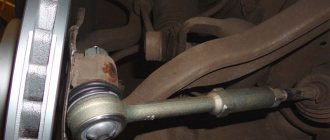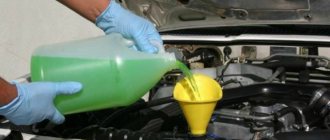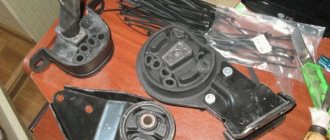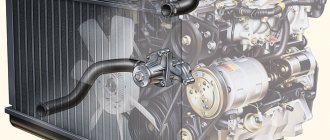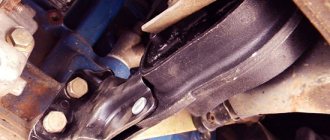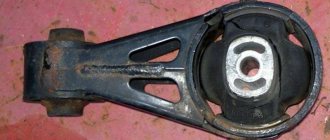The cooling radiator is one of the most important parts of the car engine cooling system . A radiator failure can lead to engine overheating and, as a consequence, subsequent failure. The consequence of engine overheating may be a major overhaul of the engine and the entire cooling system. In this case, you can consider installing a power unit from a foreign car.
Replacement of cooling radiator VAZ 2113, 2114, 2115
During vehicle operation, various damage to the cooling radiator is possible, as a result of which the coolant level decreases, which in turn can lead to engine overheating and costly repairs. Therefore, if a VAZ 2113, 2114, 2115 needs to replace the cooling radiator, there is no need to hesitate - we buy a new one and carry out the repairs ourselves, following the step-by-step instructions in the photo and video.
Required spare parts
First of all, you need to select a new radiator. It is better to purchase an analogue of what is on your car. You can also make a choice by article number: 2108-1301012, 21082-1301012, RO2108-01, LRc 01082.
The average price of a new unit is 1,750 rubles. Copper models will cost more.
Tools required for repairs
If you want to do the repairs yourself, you need to prepare the following tools:
- keys for 8 and 10;
- screwdrivers;
- heads for 8 and 10;
- pliers;
- container for draining antifreeze;
- jack;
- sealant;
- rags.
Independent work is completely justified, since as of March 24, 2019, the average price for replacing a cooling radiator for a VAZ 2114 and other models is 2.2 thousand rubles. Which will more than double costs.
Order of Operations
If the car has a low seating position or the coolant drain tank is large, work should begin by lifting the car with a jack. The radiator is installed on the TV along with fog and regular headlights. Work should only begin with a cold engine. If the engine is hot, be sure to wait until it cools down.
Now you can get started:
- After removing the plug from the expansion barrel, the working fluid is drained into a container. It is necessary to drain all the antifreeze that is in the cooling system.
- Now you need to dismantle the filter.
- The radiator must be removed together with the electric fan. To do this, you need to disconnect the power supply to the cooler. Now you need to unscrew the pressure plate and remove it.
- Now you need to remove the inlet and outlet hoses from the pipes. To do this, loosen the fastener clamp.
The radiator with fan is tilted towards the engine and removed. Attention! Before pulling out the fan, you need to disconnect the wires. They are usually located at the bottom of the device. This is necessary in order to maintain the functionality of the wiring.
- Now you need to disconnect the fan from the radiator. To do this, use a 10mm wrench to unscrew 2 nuts. The fan must be removed along with the casing.
- Installation of the radiator is carried out in the reverse order to that described above. It begins with switching the new node and the fan. Important! Before replacing, make sure that there are 2 rubber cushions. If they are missing, install new ones in the crossmember holes. If they are in place, then the installation of the new unit is carried out on them.
- mechanical shocks, for example, stones bouncing off the wheels of passing vehicles;
- pockets of corrosion and contamination inside the tubes;
- damage in an accident.
The main causes of radiator malfunction
The most common reasons for radiator failure on VAZ 2113, 2114, 2115 are:
Let's summarize
In general, repairs are quite accessible for doing it yourself, but you need to immediately prepare for a significant time investment. Work can last for 2-6 hours. When replacing the radiator, it is necessary to change the coolant. Work with 8-valve and 16-valve engines is carried out in the same way. If the car has air conditioning, you will have to remove and install it during the repair, but not on all models. It is advisable to replace the bushings at the same time. The work is completed by checking the functionality of the engine and the condition of the coolant. Namely, whether it is boiling.
For greater clarity on replacing the VAZ 2115 injector cooling radiator, you can watch this video:
The case of the Samara family
Next, we’ll look at how to replace the cooling radiator in VAZ 2114 cars with your own hands, because it will be much cheaper than giving the car to a service station. We will need:
- automotive sealant;
- wrenches, screwdriver;
- canister of new antifreeze (8 liters);
- container for old liquid.
Note that replacing the cooling radiator on a VAZ 2115 car is identical. So where to start? Let's describe everything step by step.
- We drain the antifreeze through the lower hole of the broken unit, while the engine is cool, the expansion tank cap is removed, and the heater lever in the cabin is moved to maximum heat. On the cylinder block, we also unscrew the plug from the bottom near the ignition module and free the engine from antifreeze.
- Disconnect the air filter housing from the engine.
- We loosen the screws of the clamps of two large hoses, the inlet and outlet hoses, as well as the small steam outlet, separate all the hoses, and carefully move them to the side.
- It is easier to remove the radiator when assembled with a fan, so first disconnect the electrical connector of the fan and unscrew the pressure plate.
- We separate the broken element from all the fasteners, tilt it slightly towards the engine, then pull it out.
- Unscrew the three fasteners and remove the fan.
The new element is installed in the reverse order, only the connections are pre-lubricated with sealant. Before adding fresh fluid, do not forget to tighten the plugs under the new unit and under the engine.
As you can see, replacing a cooling radiator on a car is not a complicated operation at all.
Option with "ten"
Now let’s look at how to perform a similar procedure in a VAZ 2110 car. The reasons for the unit failure here do not differ from those described above.
Also find out how to change the fuel filter on a VAZ 2114 and what is the frequency of replacing the air filter.
To work, we will need everything the same as in the first case, so let’s immediately move on to describing the process.
- Drain the coolant with the tank cap unscrewed and the heater tap open. There is a drain plug on the radiator at the bottom left, and on the engine block - at the bottom near the gearbox. The air filter housing is a nuisance, but can be left in place.
- To replace the cooling radiator in a VAZ 2110 car, you must first remove the fan. Therefore, we disconnect the power supply from it, unscrew the bolts on the left, as well as from the bottom. Pull the fan up and remove it.
- Loosen the clamps of the inlet and outlet hoses and remove the hoses.
- We release the leaking lattice element from the upper fastening and pull it out, slightly tilting it towards the piston unit.
Installation of the new system is carried out in the reverse order with sealant applied to the connections; the main thing is not to forget to close the drains again before filling with liquid.
The case of Kalina
Next, let's talk about replacing the cooling radiator on the next model - Lada Kalina. Failure of such an important unit in Kalina is possible for one of the previously mentioned reasons:
- minor mechanical damage;
- road accident;
- clogging or rust through.
The best treatment for a leaking cooling unit is to buy a new unit. Let's consider step by step the entire process of replacing the engine cooling radiator on any Kalina.
For work you will need:
- keys and heads for 8 and 10;
- pliers;
- screwdriver;
- sealant.
Algorithm for replacing the VAZ 2115 radiator
If the engine overheats severely, major repairs and large cash injections will be required. To prevent this, you need to monitor the coolant level, proper operation of the thermostat, and the condition of the engine cooling radiator.
Wet marks or a hole in the radiator, a coolant leak or fluid accumulation during long-term parking require immediate repair of the engine radiator. You can try soldering the radiator if the crack is small. In addition to cracks and holes, poor connections and loose clamps can lead to leaks. If this is not the case, and repairs are not financially viable, you will need to replace the radiator .
Worth checking out:
You can replace the radiator at a service station or yourself.
Algorithm for replacing the VAZ 2115 radiator
- Empty the radiator and drain the coolant located in the engine cooling system.
- Remove the radiator with electric fan (if you have a VAZ-2111, you will need to remove the air filter housing).
- Using an “8” socket wrench, unscrew the 2 nuts of the pressure plate and remove it.
- The radiator inlet hose must be removed from the outlet pipe by lowering the mounting clamp to do this.
Also check out
- We remove the radiator outlet hose from the thermostat.
- Tilt the radiator towards the engine, and lower the clamp of the radiator steam exhaust hose. Remove it carefully so that the plastic fitting is not damaged.
- Remove the cooling radiator and fan, lowering it towards the engine. If you plan to repair the radiator, do not disconnect the fan from it. If the radiator needs to be replaced, the fan should be removed and installed on a new part.
- Using a “10” wrench, unscrew 2 mounting bolts, 1 nut and remove the electric fan.
- Using a 10mm socket wrench, unscrew the nut on the upper mount of the fan to the radiator.
- Using the “8” socket, unscrew the 2 nuts that secure the pressure plate and remove it.
- Remove the shroud and cooling fan.
Current:
Before replacing the radiator, make sure that there are 2 rubber pads at the installation site. The radiator must be installed on them, and they must be fixed in the holes of the cross member.
This completes the replacement of the VAZ 2115 radiator. You need to put everything back together and fill it with coolant.
We recommend reading
We will talk about removing the VAZ 2115 starter if there is a need for repair or replacement. Removing the starter varies on different cars: on .
One of the problems that occurs with headlights is damaged headlight optics. Next we will talk about how to replace headlights.
The knock sensor, as the name implies, is necessary to monitor knocking inside the engine and knocking noises that indicate existing knocking.
"Poker" (metal hood support) makes many car owners feel uncomfortable. To get rid of it, you need to install .
Some useful tips
- To drain the coolant, you need to unscrew the plugs on the radiator, on the expansion tank and on the engine cylinder block.
- If the cooling system is not functioning well, the culprit may be a liquid cooling pump whose shaft bearings or seals have failed. It needs to be repaired or replaced with a new product.
- The cause of failure of the cooling system may be improper operation of the thermostat, which must be repaired or replaced.
- It is more convenient to remove the radiator together with the fan. The fan can be removed later if necessary.
You can check the tightness of the removed radiator as follows:
- fill the bathtub with water;
- lower the product into water and apply pressure of approximately 0.2 MPa;
- bubbles will show where leaks have appeared.
Sometimes, to bring the radiator into working condition, it is enough to rinse it with water. It's done like this. The antifreeze or antifreeze is drained and clean distilled water is poured in. The engine starts and runs at 3000 rpm. The temperature should be monitored. They turn off the car and after 7-8 minutes drain the water. If it is not completely clean, the procedure can be repeated. If the fluid has changed color, it needs to be replaced.
The coolant should be changed: antifreeze - after 2 years, antifreeze - after 5 years. The best choice for cooling fluid is antifreeze. The standard cooling system fan is quite noisy. Therefore, it makes sense to replace the original four-blade impeller with a new eight-blade one. When purchasing an impeller, you need to remember that the shaft for its attachment can have a landing thread of 8 mm and 6 mm.
How to change the radiator on a VAZ 2115
Radiator VAZ 2115
Engine overheating is a terrible phenomenon that promises its owner major repairs and serious cash injections. In order to prevent engine overheating, it is necessary to regularly monitor the coolant level, proper operation of the thermostat, and the condition of the engine cooling radiator.
If you find a coolant leak or puddles after a long period of parking, check the engine radiator for coolant leaks. A wet mark or hole in the radiator is a signal for immediate action. If the crack or breakdown is small, you can try to solder the cooling radiator. In addition to cracks and holes in the radiator, leaks can be caused by faulty connections or loose clamps. If the reason is not the clamps, and repairing the radiator is impossible or unprofitable, the radiator will need to be replaced.
How to remove
1) First, drain all the liquid from the cooling system (How to drain the liquid, read the article: “Replacing the coolant on a VAZ”), when the coolant is drained, remove the air filter housing so that it does not interfere (How to remove the housing, read “in this article") and after the completed operations, you can begin to unscrew all the bolts that secure the fan to the radiator (Without unscrewing them, you will not remove the radiator), but just do not forget to also disconnect the pipes before unscrewing, they are fastened with screws, there are only three pipes that fit radiator (Two large, one small), when they are already disconnected, you can begin to unscrew the bolts and nuts securing the fan, there are only two such bolts, but in addition to the bolts, the fan is also held in place by nuts (And there are only four nuts), one nut is located in the the lower part of the fan on the side (It is easy to see if you remove the crankcase protection and crawl under the bottom of the car) and the other three are at the top (see small photo, they are indicated by arrows) and two of these three nuts also hold the pressure plate (Indicated by red arrows ), so when the nuts are unscrewed, remove this plate and put it away, but just be careful not to lose it, otherwise in this case you will have to go to the auto shop for a new one, and when all four remaining nuts are unscrewed, remove the fan by tilting it towards the engine and pulling it out up (On 16-valve cars, you can’t remove it to the top, because the engine will get in the way, so both the radiator and the fan are removed through the bottom).
Testing modern sealants
To increase the tightness of the cooling system and eliminate leaks in the radiator, there are special sealant compositions for car owners. Different experts have mixed attitudes towards the use of sealants, by analogy with oil additives and tablets in a gasoline tank. Car manufacturers have a negative attitude towards the use of sealants. In the car maintenance manuals in the engine cooling section there is no mention of any additives. They respond to leaks by replacing the old radiator with a new one.
What to do if the antifreeze level has dropped significantly on the road, but the road to the place is still far away. There is a way out. Retail outlets and fuel filling stations sell additives that can eliminate leaks. This is an emergency method that allows you to get to a nearby service station without problems. It is not possible to prevent a radiator from leaking forever using a sealant. The main task of additives was the formation of deposits in the cooling system of cars.
You can simplify the selection using a summary table that has two characteristics: the level of deposits and the time of clogging of different holes. To assess the level of deposits, the mass of the thermostat was used before and after the use of additives. Such tests are usually carried out at institutes at the department of internal combustion engines.
From the table you can see that microcracks are easily repaired, and even large holes are clogged within 10 minutes. The use of radiator sealants is an emergency. There is no point in using them for preventive purposes. If possible, replace the faulty part and thoroughly flush the cooling system of the machine.
How to properly replace a radiator
Before replacing the radiator in their car, many car owners ask the question: “how to remove the cooling radiator?” In this article you will find answers to your questions.
How to remove the radiator?
Radiator and fan parts:
- Radiator.
- Radiator tank.
- Electric motor.
- Casing.
- Impeller.
- Rubber cushion.
- Drain plug.
So, before starting work, you should remember that the entire removal and installation process takes place on a cold engine.
- First of all, we unscrew the cap of the expansion tank (do not forget about the radiator and cylinder block caps - they also need to be removed).
- Drain the coolant into a clean container.
- Disconnect the radiator fan from the power supply.
- We disconnect all the hoses, both from the radiator and the expansion tank.
- Then we proceed to unscrewing the nuts from the cooling system casing.
- Hold the radiator and remove the casing with the fan.
- The radiator is free and ready to be removed.
If necessary, you can also disconnect the casing from the fan to remove the electric motor.
How to install a radiator?
After removing the radiator, replacing it or repairing it, you need to put it in place and secure it. Radiator installation is described in this article: How to install a radiator?
Installation of the cooling radiator is carried out step by step in the reverse order of removal.
- First of all, we string the radiator itself and cover it with a fan and casing.
- After tightening the nuts, connect the tubes, install the plugs, and connect the radiator fan.
- Fill with coolant and close the lid.
- We start it up, check our final result and that’s it.
Radiator repair
The most common reason for replacing or repairing a radiator is the loss of coolant due to the presence of a hole.
Typically, coolant leaks from the junction of metal and plastic. And if the leak is not large, then solving this problem yourself is quite simple. Along with the coolant, we add a special mixture to the radiator (sold in the store) and after a while the leak will go away on its own. Otherwise, you cannot do without purchasing a new radiator.
Checking the radiator tightness
To check the tightness of the radiator, do the following:
- Fill the bath with water.
- We plug all the holes in the pipes.
- We lower it into the bath by 20-40 cm and apply pressure to the radiator in the amount of 0.2 MPa (2 kgf/cm 2 ).
- We look at the result in the form of the presence or absence of bubbles.
Radiator replacement
Also, a forced replacement of the radiator occurs after the car is involved in an accident, both in a frontal and side collision.
Reasons for removing a cooling system element
When a car breaks down, some reasons lead to the need to remove the radiator. The main ones:
- various types of mechanical damage;
- individual radiator tubes are clogged with dirt, deposits in the form of scale and rust;
- getting a car into an accident.
Replacing the device in question is not always required. Sometimes it can be repaired, washed, soldered. Modern radiators often have an aluminum core and a plastic tray. Such models are very difficult to repair.
To eliminate the malfunction or replace it, you will need to dismantle the device. You need to take this work very seriously and do it carefully. In order for the process to be carried out efficiently, you need to at least briefly know what parts the radiator assembly consists of. It includes:
- device body;
- expansion tank;
- Electrical engine;
- engine casing;
- impeller (fan);
- rubber cushion;
- drain plug;
- various hoses;
- a pump that is powered by a drive belt.
How to correctly replace the heater radiator on a VAZ 2114 with removal and installation
The VAZ-2114 and VAZ-2115 models are in stable demand. These are inexpensive, quite dynamic and comfortable cars, with affordable spare parts. From time to time they have problems with the heating system, many of which can only be solved by replacing the radiator of the VAZ-2114 or model 2115 stove. You can do this yourself, and without removing the dashboard, as required in the operation and repair manual.
The design of the heating system VAZ-2114
The design of the heating system for cars of the Samara-2 family, including the VAZ-2114 and 2115, was unified to reduce the cost of production and the cost of cars. It is simple and reliable, but from time to time some of its elements fail. The heating system consists of:
- radiator-heat exchanger with connected pipes;
- faucet that shuts off the coolant supply;
- air duct systems with dampers;
- fan for air supply;
- control block.
The air is heated by feeding it through the honeycomb of the stove radiator. The flow is forced by a fan and directed through the air ducts by dampers. The entire system is controlled by a special unit from the driver's seat. In the warm season, the tap allows you to shut off the supply of coolant through the heat exchanger. If the radiator of the VAZ-2114 stove leaks or remains cold when the tap is open, the only solution is to replace it.
Causes of radiator failure
The need to replace the stove radiator arises in several cases. If the heat exchanger remains cold even when the heat supply is set to maximum, it is highly likely to become clogged. The reason is scale that forms at high temperatures and settles in the radiator tubes or pipes connected to it. The second reason is a burst and depressurized radiator or pipes. When this breakdown occurs, antifreeze begins to flow into the passenger compartment on the passenger side, the mats become wet, and a characteristic unpleasant odor appears in the car.
In both cases, be it a cold heater radiator or an antifreeze leak, this unit will need to be replaced, since it cannot be repaired. Copper heat exchangers can be temporarily soldered, but this will not solve the problem for a long time; the part will still need to be replaced. This must be done as quickly as possible, since driving a car with a damaged heating system is uncomfortable and can be dangerous, since fogged or frozen windows impair visibility.
Tools and materials
To replace the heater radiator in a VAZ-2114 you do not need expensive and complex tools or equipment. It is enough that almost every car enthusiast has a new spare part in his garage. To complete the job you will need:
- new heater radiator - aluminum or copper;
- a set of ring and open-end wrenches, you can use a set of sockets with a ratchet;
- curly screwdriver;
- set of hexagons;
- container for draining antifreeze;
- fresh coolant, no more than 4 liters.
Work order
Replacing the radiator of a VAZ-2114 stove without removing the dashboard allows you to save time, and this does not require any special skills. Let’s immediately make a reservation that part of the torpedo will still have to be disassembled, but the center console will remain in place, and this is the most labor-intensive part of the operation. At the initial stage of work, the side part of the panel on the passenger side is removed; to do this, use a screwdriver to unscrew the screws securing it.
To drain the coolant, you need to unscrew the bolts of the front protection, which is located under the engine compartment. The antifreeze is drained through a special plug located in the cylinder block; to unscrew it, you will need a 13 mm spanner. To prevent it from spilling on the ground or the garage floor, a container is placed under the car. To increase the rate at which antifreeze flows out, you can open the cap of the expansion tank.
Using a hexagon on the passenger side, the torpedo mount is unscrewed, after which it can be easily bent.
Next, you need to unscrew another fastener, located on the passenger side under the lower part of the center console. After this, the torpedo can be easily raised so that it remains in the same position, a stop of suitable length can be installed under it; a block with a cross-section of 50x50 mm and a length of about 40 cm is enough.
In the opened space you can see the heater radiator, which is attached to three self-tapping screws. They must be unscrewed so that it can be safely removed from the socket. In this case, a problem will arise - another self-tapping screw is hidden behind the plastic body of the torpedo, which needs to be unscrewed. To get to it, it is advisable to drill a small hole in the plastic through which you can insert a screwdriver. To do this, you first need to remove the glove compartment. If you try to move the torpedo, you can break the plastic and then removing the heater radiator on a VAZ-2114 will turn into an expensive procedure.
Next, you can proceed directly to dismantling the heater radiator. To do this, remove the clamps and disconnect the pipes, under which it is better to place a small container or rag, since there is still antifreeze in the system, which will spill directly into the cabin. After this, the radiator is removed from the mounting socket without any effort. It is advisable to examine it to see where the damage was and where the antifreeze is leaking from; corrosion damage appears in this place and streaks are visible, which once again confirms that the stove radiator needs to be replaced.
The new heater core fits into place effortlessly and should not cause any problems. It is secured with self-tapping screws, including through a hole previously drilled in the dashboard. In this case, it is advisable to inspect the faucet, since this is another weak point of the heating system. It should be completely dry and the lever should be easy to turn. The glove compartment is installed in place, the dashboard and the removed side panel are screwed to the mounts.
Before adding coolant, you need to check whether the plug on the cylinder block is tightened so that the coolant does not spill out. Fresh antifreeze is poured into the expansion tank to the level; if during operation the level drops, it will have to be topped up.
To carry out the tests, you need to start the engine and, after waiting until it warms up, turn on the heater. It should heat well in different modes, and the interior should remain dry, without stains of spilling antifreeze with a characteristic odor. At first, it is recommended to periodically look at the floor to make sure that all connections are tight and the new radiator is not defective.
